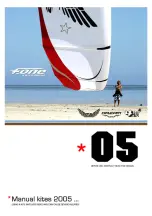
41
As this launch technique can be difficult and turning the wrong way can
result in the pilot taking off with twisted risers. It is recommended to
practice the reverse launch on a training hill or slight slope first.
When deflating the canopy in strong winds, or aborting a launch, use the
C-risers, not the brakes. Using the brakes in strong wind will cause more
lift, lifting the pilot up and dragging him/her much further back.
Turns:
The NOVA ARGON is responsive and reacts directly and instantly to any
steering input. Weight shift input quickens turns and ensures minimal
height loss.
A combined technique of weight shift and pulling on the inside brake line
is the most efficient turning method, whereby the radius of the turn is
determined by the amount of inside brake pulled and weight shift
A stalling wing tip announces itself by a gentle surge backwards of the
wingtip. In this situation you have to loosen brakes immediately.
In case it is impossible to control the NOVA ARGON with the brake lines
the C-risers may be used to steer and land the canopy.
CAUTION: PULLING A BRAKE TOO FAST OR TOO HARD CAN RE-
SULT IN THE CANOPY ENTERING A NEGATIVE SPIN.
(SEE “SPIN“ FOR REMEDY)
Spiral dive:
To enter a spiral dive with a NOVA ARGON the pilot must use weight
shift while slowly applying more and more brake on one side.
During a spiral dive the angle of bank can be controlled by increasing or
reducing the amount of inside brake.
When spiraling the NOVA ARGON it is recommended to apply some
outside brake. This helps stabilize the wing and enables an easier and
safer exit from the spiral.
To exit, ease off the inside brake slowly. The NOVA ARGON did not show
a tendency to remain in a stable spiral during testing. However, should a
glider in abnormal conditions (e.g. asymmetrical cross strap settings)
continue to spiral, it should be actively exited. This is done by weight
shifting to the outside wing and more gentle braking of the outside wing.
NEVER DO BIG EARS IN SPIRALS, AS THIS MAY DRASTICALLY
REDUCE THE NUMBER OF LINES TAKING THE ALREADY HIGH
LOADS, CAUSING STRUCTURAL FAILURE.
Summary of Contents for ARGON 20
Page 1: ...1 BETRIEBSHANDBUCH ARGON ...
Page 5: ...5 ...
Page 28: ...28 ...
Page 29: ...29 MANUAL ARGON ...
Page 30: ...30 ...
Page 51: ...51 ...
Page 54: ...54 ...
Page 55: ...55 Manuel d utilisation ARGON ...
Page 56: ...56 ...















































